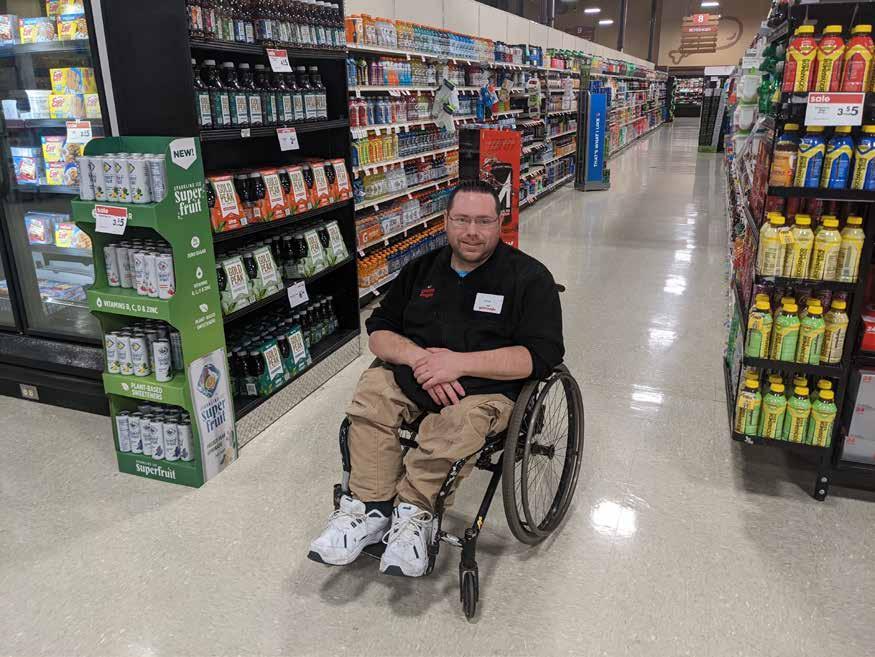
4 minute read
May 2023 Special Needs Living Akron/Canton
LETS TALK ACCESSIBILITY
Kevin Jordan shares his view from his wheelchair
Advertisement
WRITTEN BY KEVIN JORDAN

Hello! My name is Kevin Jordan. I was featured in the October edition of the magazine and was born with Spina Bifida which is a birth defect where a portion of the spine does not completely form leaving paralysis and other medical issues. It has not always been the easiest growing up however I have managed it the best I could with the help of my family. The one thing I felt was hardest for me is handicap accessibility in some places. For instance, I can go into one store and get through it with my chair just fine, then I go into the next store, and I have a difficult time.
I have also often found many places where they had a second floor with no elevator or other types of accessibility. I would love to see so many other places such as stores, churches, restaurants, and even playgrounds to be more open to people with different disabilities. I know there are some but there still are not enough. I would love to see this become a bigger priority going forward in the near future. I would love it if more businesses would be open to making sure they do whatever they can to ensure all customers and people can be comfortable in their locations regardless of ability level.
According to Forbes in an article published in July of 2022, there are 5 simple ways you can make your business more welcoming and accessible to customers with disabilities.
1. EASY PARKING AND ENTRANCES.
People with various disabilities who drive choose businesses with the most accessible and available parking spaces. Designating handicapped parking spaces need to be laid out and marked in a certain way, something that is still overlooked and misunderstood. The spaces should be as close as possible to the main customer entrance and generally 8 feet in width. The also should have marked “access aisles” adjacent so the driver has room to get out of their vehicle without hitting a neighboring car.
2. ENSURE WIDER PATHWAYS WITH LESS CLUTTER.
People with disabilities, especially those with mobility impairments, need space to move. For a start, they need wide, smooth sidewalks to get easily in and out of your business. Accessibility of this kind cannot stop at the door either. Once inside, people with disabilities oftentimes need wide, clear pathways, product aisles, and gathering areas. Having enough clear space to walk or turn a wheelchair around without crashing into product displays or other customers is vital to a person with a disabilities experience inside of your location.
3. HAVING REACHABLE, USABLE, AND WELL-LIT INTERIORS.
High shelves, service counters, and tables are bad for wheelchair users, and others who have more trouble than
most reaching higher-up items to see or grab within your business. Try to be as creative as you can to keep the things you want customers to see, use and buy on lower levels. As a good general rule, think in terms of keeping things to be reached and handled below 4 feet high if possible.
4. WHEELCHAIR-ACCESSIBLE RESTROOMS.
For restaurants especially, good, accessible restrooms are key. In any place where you hope your customers will stay longer than a half hour, they need to be able to access the restroom. Restroom accessibility is one of the more complicated things in terms of proper design. Take the time to look up and fully understand all of the requirements. If possible get professional help before you try to approach it as a DIY project.
5. ENSURING YOUR STAFF IS AWARE AND RESPONSIVE.
It should not need to be said but it is always worth repeating. Physical accessibility is only part of making a business more welcoming to people with disabilities. It is much harder to adjust door widths and toilet placements, however, staff attitudes and practices can change a person with a disabilities experience inside of your business. Helpful and considerate staff members can even help compensate for at least some aspects of a less-than-ideal physical accessibility issue.











